设计周期表模板
MSD生产计划周期EXCEL模板
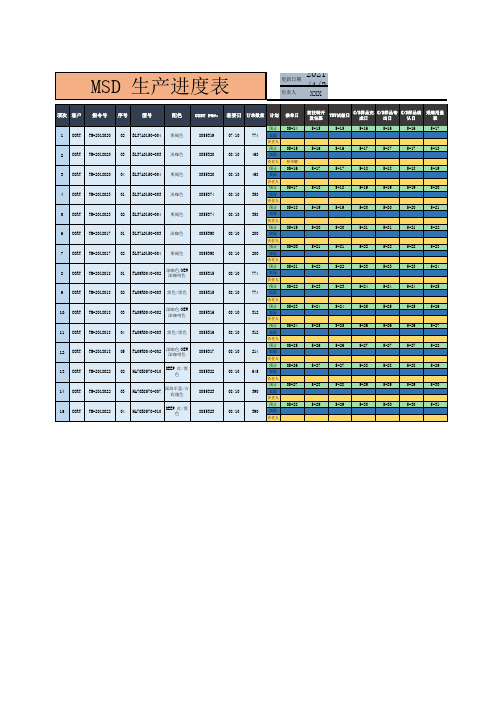
8055398
8
CORT TM-2018018
01
FA09R0040-002
深咖色/NEW 深咖啡色
8055315
9 CORT TM-2018018 02 FA09R0040-003 黑色/黑色
8055315
10 CORT TM-2018018
03
FA09R0040-002
深咖色/NEW 深咖啡色
8055316
5-26
5-27
5-26
5-26
5-27
5-27
5-27
5-28
5-27
5-27
5-28
5-28
5-28
5-29
5-28
5-28
5-29
5-29
5-29
5-30
5-29
5-29
5-30
5-30
5-30
5-31
预计 05-14 774 实际
责任人 预计 05-15 468 实际 责任人 林毕耀 预计 05-16 468 实际 责任人 预计 05-17 358 实际 责任人 预计 05-18 358 实际 责任人 预计 05-19 200 实际 责任人 预计 05-20 200 实际 责任人 预计 05-21 774 实际 责任人 预计 05-22 774 实际 责任人 预计 05-23 312 实际 责任人 预计 05-24 312 实际 责任人 预计 05-25 214 实际 责任人 预计 05-26 645 实际 责任人 预计 05-27 390 实际 责任人 预计 05-28 390 实际 责任人
前技转开 发包裹
TRY试做日
C/S样品完 成日
C/S样品寄 出日
C/S样品确 认日
小程序及app项目定制开发进度计划表模板
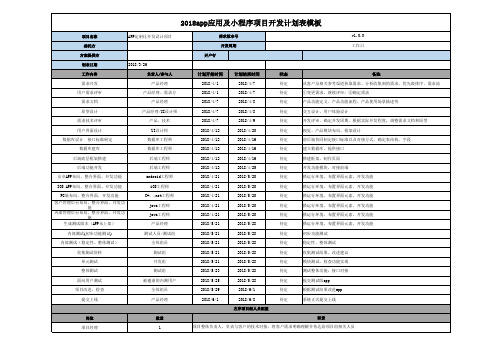
状态 待定 待定 待定 待定 待定 待定 待定 待定 待定 待定 待定 待定 待定 待定 待定 待定 待定 待定 待定 待定 待定 待定 待定 待定
备注 从客户及相关参考渠道获取需求、分析收集到的需求、优先级排序、需求池 ①变更需求,继续评审;②确定需求 产品功能定义、产品功能流程、产品使用场景描述等 交互设计、用户体验设计 开发评审、确定开发周期、根据实际开发程度,调整需求文档和原型 视觉、产品模块布局、框架设计 前后端协同制定接口标准以及对接方式,确定表结构、字段 建立数据库,提供接口 搭建框架,制作页面 开发功能模块,对接前端 搭运行环境,布置界面元素,开发功能 搭运行环境,布置界面元素,开发功能 搭运行环境,布置界面元素,开发功能 搭运行环境,布置界面元素,开发功能 搭运行环境,布置界面元素,开发功能 搭运行环境,布置界面元素,开发功能 初步功能测试 稳定性、整体测试 收集测试结果、改进建议 模块测试,检查功能实现 测试整体功能,接口对接 提交测试版app 根据测试结果改进app 系统正式提交上线
岗位
数量
职责
项目经理
1
项目整体负责人,负责与客户的技术对接,将客需求明确理解并传达给项目组相关人员
产品经理 系统架构师 C#、.net工程师 安卓工程师 IOS工程师 UI设计师 测试工程师 整体开发报价(人民币:元,不含税)
1 1 1 2 2 1 1
将客户需求产品化,用可实现的技术性语言撰写产品计划 完成项目需求的完整系统架构的设计和开发跟进 网页版管理平台的开发设计 安卓版APP的开发设计 IOS版APP的开发设计 根据客户需求的风格进行整体页面的UI设计 对相关开发成果进行阶段性和整体性测试,反馈 开发起始日以我方收到客户首期款计算,开发周期为50个工作日,如开增值税发票需在开票额基础上加入税点
软件开发项目工作计划表格模板

软件开发项目工作计划表格模板软件开发项目工作计划表格模板(一):软件开发项目计划模板(参考后编制) xxx软件项目计划任务书项目编号项目名称撰写人审批完成日期版本记录目录1. 项目背景、范围及目标 ................................................................. .................................................... - 1 - 2. 项目可行性分析...................................................................... .............................................................. - 1 - 3. 项目概述 ................................................................. ........................................................................ ......... - 1- 4. 项目生命周期及里程碑计划 ................................................................. .......................................... - 1 - 5. 项目任务分解结构(wbs)................................................................... ........................................... - 1 - 6. 预算 ..................................................................... ........................................................................ ............... - 2 - 7. 人员组织及分工.................................................................. .................................................................. - 2 - 8. 风险预估 ..................................................................... ........................................................................ ..... - 2 -i1. 项目背景、范围及目标简述项目开发背景及意义、要解决的问题和需要达到的目标。
元素周期表(Periodic Table)-multiple version
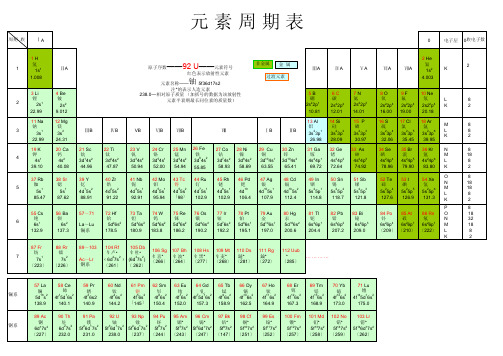
镧系57 La镧5d16s2138.958 Ce铈4f15d16s2140.159 Pr镨4f36s2140.960 Nd钕4f46s2144.261 Pm钷4f56s2〔145〕62 Sm钐4f66s2150.463 Eu铕4f76s2152.064 Gd钆4f75d16s2157.365 Tb铽4f96s2158.966 Dy镝4f106s2162.567 Ho钬4f116s2164.968 Er铒4f126s2167.369 Tm铥4f136s2168.970 Yb镱4f146s2173.071 Lu镥4f145d16s2175.0锕系89 Ac锕6d17s2〔227〕90 Th钍6d27s2232.091 Pa镤5f26d17s2231.092 U铀5f36d17s2238.093 Np镎5f46d17s2〔237〕94 Pu钚5f67s2〔244〕95 Am镅*5f77s2〔243〕96 Cm锔*5f76d17s2〔247〕97 Bk锫*5f97s2〔147〕98 Cf锎*5f107s2〔251〕99 Es锿*5f117s2〔252〕100 Fm镄*5f127s2〔257〕101 Md钔*5f137s2〔258〕102 No锘*5f147s2〔259〕103 Lr铹*5f146d17s2〔262〕/'silv ə(r)//'læθənaid//'haidr əd ʒən/氢/'li θi əm/锂/b ə'rili əm/铍/'b ɔːr ɒn/硼/'k ɑːb ən/碳/'naitr əd ʒən/氮/'ɒksid ʒən/氧/'hi ːli əm/氦/'ni ːɒn/氖/'fl ɔːri ːn/氟/ælj ə'mini əm/铝/'silik ən/硅 /'f ɒsf ər əs/磷/‘s ʌlf ə(r)/硫/'kl ɔːri ːn/氯/’ɑːg ɒn/氩 /‘gæli əm/镓/d ʒɜː'meini əm/锗 /'ɑːsnik/砷/s ə'li ːni əm/硒/'br əʊmi ːn/ 溴/'kript ɒn/氪/'indi əm/铟/tin/锡/'æntim əni/锑 /'telj ʊəri əm/碲 /'ai ədi ːn/碘/'zen ɒn/氙/'θæli əm/铊/li ːd/铅/'bizm əθ/铋/'p əl əʊni əm/钋/'æst əti ːn/砹/'reid ɒn/氡/'s əʊdi əm/钠/mæg'ni ːzi əm/镁/p ə‘tæsi əm/钾/'kælsi əm/钙/'skændi əm/钪/ti'teini əm/钛/v ə'neidi əm/钒/'kr əʊmi əm/铬/'mæŋg əni ːz/锰/ai ən/铁/'k əʊb ɔːlt/钴/'nikl/镍/'k ɒp ə(r)/铜 /zi ŋk/锌/r ʊ'bidi əm/铷/'str ɒnti əm/锶/'itri əm/钇/z ɜː'k əʊni əm/钇/nai'əʊbi əm/铌/m ə'libd ən əm/钼/tek'ni ːʃɪəm/锝/ru ː'θi ːni əm/钌/'r əʊdi əm/铑/p ə'leidi əm/钯/'kædmi əm/镉/'m ɜːkj əri/汞/g əʊld/金/'plætin əm/铂/I'ridi əm/铱/'ɒzmi əm/锇/'ri ːni əm/铼/'t ʌŋst ən/钨/'tænt əl əm/钽/'hæfni əm/铪 /'silv ə(r)/银 /'læn θənaid/镧/'be əri əm/钡/'si ːzi əm/铯/'frænsi əm/钫/'reidi əm/镭/æk'tini əm/锕/'læn θən əm/镧/'si əri əm/铈/preizi əʊdimi əm/镨/ni ːəʊ'dimi əm/钕/pr ə'mi ːθi əm/钜/s ə'me əri əm/钐/j ʊər'əʊpi əm/铕/gæd ə'lini əm/钆/'t ɜːbi əm/铽/dis'pr əʊzi əm/镝/dis'pr əʊzi əm/镝 /'ɜːbi əm/铒 /'θu ːli əm/铥/i't ɜːbi əm/镱/lu ː'ti ːʃi əm/镏/æk'tini əm/锕/'θɔːri əm/钍/pr əʊtæk'tini əm/镤/ju'reini əm/铀/'ælk əlai/ 碱金属/'ælk əlain/ 碱土金属金属/'metl ɔɪd/类金属非金属/'hæl əd ʒən/ 卤素/'n əʊbl/ 稀有气体/'læn θənaid/ or /æk'tinaid/ 稀土元素NOBLE GASES1H 1.008Hydrogen1s1Oxidation States Electroneg.12.2Atomic Radius Ionic Radius 37–Electron Affinity 1st Ion. Pot.0.7513.603Li 6.94Lithium 1s 22s 1Oxidation States Electroneg.10.98Atomic Radius Ionic Radius 152(+1)76Electron Affinity 1st Ion. Pot.0.62 5.394Be 9.01Beryllium1s 22s 2Oxidation States Electroneg.2 1.57Atomic Radius Ionic Radius 111(+2)45Electron Affinity 1st Ion. Pot.Unstable Anion 9.3212Mg 24.31Magnesium [Ne]3s 2Oxidation States Electroneg.2 1.31Atomic Radius Ionic Radius 160(+2)72Electron Affinity1st Ion. Pot.Unstable Anion 7.6521Sc 44.96Scandium [Ar]3d 14s 2Oxidation States Electroneg.3 1.36Atomic Radius Ionic Radius 161(+3)75Electron Affinity 1st Ion. Pot.0.19 6.5639Y 88.91Yttrium [Kr]4d 15s 2Oxidation States Electroneg.3 1.22Atomic Radius Ionic Radius 178(+3)102Electron Affinity 1st Ion. Pot.0.31 6.2257La 138.9Lanthanum [Xe]5d 16s 2Oxidation States Electroneg.3 1.10Atomic Radius Ionic Radius 187(+3)116Electron Affinity 1st Ion. Pot.0.5 5.7789Ac 227Actinium [Rn]6d 17s 2Oxidation States Electroneg.3 1.1Atomic Radius Ionic Radius 188(+3) -Electron Affinity 1st Ion. Pot.– 5.17104Rf 261Rutherfordium [Rn]5f 146d 27s 2disc.1964105Db 262Dubnium [Rn]5f 146d 37s 2disc.196758Ce 140.1Cerium [Xe]4f 15d 16s 2Oxidation States Electroneg.3,4 1.12Atomic Radius Ionic Radius 183(+3)114Electron Affinity 1st Ion. Pot.– 5.5459Pr 140.9Praseodymium [Xe]4f 36s 2Oxidation States Electroneg.3,4 1.13Atomic Radius Ionic Radius 182(+3)113Electron Affinity 1st Ion. Pot.– 5.4660Nd 144.2Neodymium [Xe]4f 46s 2Oxidation States Electroneg.3 1.14Atomic Radius Ionic Radius 181(+3)114Electron Affinity 1st Ion. Pot.– 5.5361Pm 145Promethium [Xe]4f 56s 2Oxidation States Electroneg.3–Atomic Radius Ionic Radius 181(+3)109Electron Affinity 1st Ion. Pot.– 5.5562Sm 150.4Samarium [Xe]4f 66s 2Oxidation States Electroneg.3,2 1.17Atomic Radius Ionic Radius 180(+3)108Electron Affinity 1st Ion. Pot.– 5.6463Eu 152.0Europium [Xe]4f 76s 2Oxidation States Electroneg.3,2–Atomic Radius Ionic Radius 199(+3)107Electron Affinity 1st Ion. Pot.– 5.6764Gd 157.3Gadolinium [Xe]4f 75d 16s 2Oxidation States Electroneg.3 1.20Atomic Radius Ionic Radius 179(+3)105Electron Affinity 1st Ion. Pot.– 6.1565Tb 158.9Terbium [Xe]4f 96s 2Oxidation States Electroneg.3,4–Atomic Radius Ionic Radius 176(+3)118Electron Affinity 1st Ion. Pot.– 5.8666Dy 162.5Dysprosium [Xe]4f 106s 2Oxidation States Electroneg.3 1.22Atomic Radius Ionic Radius 175(+3)103Electron Affinity 1st Ion. Pot.– 5.9467Ho 164.9Holmium [Xe]4f 116s 2Oxidation States Electroneg.3 1.23Atomic Radius Ionic Radius 174–Electron Affinity 1st Ion. Pot.– 6.0268Er 167.3Erbium [Xe]4f 126s 2Oxidation States Electroneg.3 1.24Atomic Radius Ionic Radius 173(+3)100Electron Affinity 1st Ion. Pot.– 6.1169Tm 168.9Thulium [Xe]4f 136s 2Oxidation States Electroneg.3,2 1.25Atomic Radius Ionic Radius 173(+3)109Electron Affinity 1st Ion. Pot.– 6.1870Yb 173.0Ytterbium [Xe]4f 146s 2Oxidation States Electroneg.3,2–Atomic Radius Ionic Radius 194(+3)99Electron Affinity 1st Ion. Pot.– 6.2571Lu 175.0Lutetium [Xe]4f 145d 16s 2Oxidation States Electroneg.3 1.0Atomic Radius Ionic Radius 172(+3)98Electron Affinity 1st Ion. Pot.– 5.4390Th 232.0Thorium [Rn]6d 27s 2Oxidation States Electroneg.4 1.3Atomic Radius Ionic Radius 180(+4)94Electron Affinity 1st Ion. Pot.– 6.0891Pa 231.0Protactinium [Rn]5f 26d 17s 2Oxidation States Electroneg.5,4 1.5Atomic Radius Ionic Radius 161(+5)78Electron Affinity 1st Ion. Pot.– 5.8992U 238.0Uranium [Rn]5f 36d 17s 2Oxidation States Electroneg.6,5,4,3 1.7Atomic Radius Ionic Radius 139(+6)73Electron Affinity 1st Ion. Pot.– 6.1993Np 237Neptunium [Rn]5f 46d 17s 2Oxidation States Electroneg.6,5,4,3 1.3Atomic Radius Ionic Radius –(+5)75Electron Affinity 1st Ion. Pot.– 6.2794Pu 244Plutonium [Rn]5f 67s 2Oxidation States Electroneg.6,5,4,3 1.3Atomic Radius Ionic Radius 151(+4)86Electron Affinity 1st Ion. Pot.– 6.0695Am 243Americium [Rn]5f 77s 2Oxidation States Electroneg.6,5,4,3–Atomic Radius Ionic Radius 131(+3)98Electron Affinity 1st Ion. Pot.– 5.9996Cm 247Curium [Rn]5f 76d 17s 2Oxidation States Electroneg.3–Atomic Radius Ionic Radius –(+3)97Electron Affinity 1st Ion. Pot.– 6.0297Bk 247Berkelium [Rn]5f 97s 2Oxidation States Electroneg.4,3–Atomic Radius Ionic Radius –(+3)96Electron Affinity 1st Ion. Pot.– 6.2398Cf 251Californium [Rn]5f 107s 2Oxidation States Electroneg.3–Atomic Radius Ionic Radius –(+3)95Electron Affinity 1st Ion. Pot.– 6.3099Es 252Einsteinium [Rn]5f 117s 2Oxidation States Electroneg.3–Atomic Radius Ionic Radius ––Electron Affinity 1st Ion. Pot.– 6.42100Fm 257Fermium [Rn]5f 127s 2Oxidation States Electroneg.3–Atomic Radius Ionic Radius ––Electron Affinity 1st Ion. Pot.– 6.50101Md 258Mendelevium [Rn]5f 137s 2Oxidation States Electroneg.3,2–Atomic Radius Ionic Radius ––Electron Affinity 1st Ion. Pot.– 6.58102No 259Nobelium [Rn]5f 147s 2Oxidation States Electroneg.3,2–Atomic Radius Ionic Radius ––Electron Affinity 1st Ion. Pot.– 6.65103Lr 262Lawrencium [Rn]5f 146d 17s 2Oxidation States Electroneg.3–Atomic Radius Ionic Radius ––Electron Affinity 1st Ion. Pot.––106Sg 266Seaborgium [Rn]5f 146d 47s 2disc.1974107Bh 264Bohrium [Rn]5f 146d 57s 2disc.1981108Hs 269Hassium [Rn]5f 146d 67s 2disc.1984109Mt 268Meitnerium [Rn]5f 146d 77s 2disc.1982110Ds 281Darmstadtium [Rn]5f 146d 97s 1Darmstats, Germany111Uuu 272Unununium disc.1994Darmstats, Germany 112Uub 277Ununbium disc.1996Darmstats, Germany 113Uut 284Ununtrium disc.2004Dubna, Russia 114Uuq 289Ununquadium disc.1999Dubna, Russia 115Uup 288Ununpentium disc.2004Dubna, Russia 116??Notdiscovered - -117??Notdiscovered --118??Notdiscovered - -72Hf 178.5Hafnium [Xe]4f 145d 26s 2Oxidation States Electroneg.4 1.3Atomic Radius Ionic Radius 156(+4)83Electron Affinity 1st Ion. Pot.~0 6.8373Ta 180.9Tantalum [Xe]4f 145d 36s 2Oxidation States Electroneg.5 1.5Atomic Radius Ionic Radius 143(+5)64Electron Affinity 1st Ion. Pot.0.327.8974W 183.8Tungsten [Xe]4f 145d 46s 2Oxidation States Electroneg.6,5,4,3,2 1.7Atomic Radius Ionic Radius 137(+6)60Electron Affinity 1st Ion. Pot.0.867.9875Re 186.2Rhenium [Xe]4f 145d 56s 2Oxidation States Electroneg.7,6,4,2,-1 1.9Atomic Radius Ionic Radius 137(+7)53Electron Affinity 1st Ion. Pot.0.157.8876Os 190.2Osmium [Xe]4f 145d 66s 2Oxidation States Electroneg.2,3,4,6,8 2.2Atomic Radius Ionic Radius 134(+4)63Electron Affinity 1st Ion. Pot.1.108.777Ir 192.2Iridium [Xe]4f 145d 76s 2Oxidation States Electroneg.2,3,4,6 2.2Atomic Radius Ionic Radius 136(+4)63Electron Affinity 1st Ion. Pot.1.579.178Pt 195.1Platinum [Xe]4f 145d 96s 1Oxidation States Electroneg.2,4 2.2Atomic Radius Ionic Radius 139(+4)63Electron Affinity 1st Ion. Pot.2.139.079Au 197.0Gold [Xe]4f 145d 106s 1Oxidation States Electroneg.3,1 2.4Atomic Radius Ionic Radius 144(+3)85Electron Affinity 1st Ion. Pot.2.319.2380Hg 200.6Mercury [Xe]4f 145d 106s 2Oxidation States Electroneg.2,11.9Atomic Radius Ionic Radius 150(+2)102Electron Affinity1st Ion. Pot.Unstable Anion 10.4481Tl 204.4Thallium [Xe]4f 145d 106s 2p 1Oxidation States Electroneg.3,1 1.8Atomic Radius Ionic Radius 170(+1)159Electron Affinity 1st Ion. Pot.0.2 6.1182Pb 207.2Lead [Xe]4f 145d 106s 2p 2Oxidation States Electroneg.4,2 1.8Atomic Radius Ionic Radius 175(+2)119Electron Affinity 1st Ion. Pot.0.367.4283Bi 209.0Bismuth [Xe]4f 145d 106s 2p 3Oxidation States Electroneg.3,5 1.9Atomic Radius Ionic Radius 155(+3)103Electron Affinity 1st Ion. Pot.0.957.2984Po 209Polonium [Xe]4f 145d 106s 2p 4Oxidation States Electroneg.4,2 2.0Atomic Radius Ionic Radius 118(+4)–Electron Affinity 1st Ion. Pot.1.98.4240Zr 91.22Zirconium [Kr]4d 25s 2Oxidation States Electroneg.4 1.33Atomic Radius Ionic Radius 159(+4)84Electron Affinity 1st Ion. Pot.0.43 6.6341Nb 92.91Niobium [Kr]4d 45s 1Oxidation States Electroneg.5,3 1.60Atomic Radius Ionic Radius 143(+5)64Electron Affinity 1st Ion. Pot.0.90 6.7642Mo 95.94Molybdenum [Kr]4d 55s 1Oxidation States Electroneg.6,5,4,3,2 2.16Atomic Radius Ionic Radius 136(+6)59Electron Affinity 1st Ion. Pot.0.757.0943Tc 98Technetium [Kr]4d 55s 2Oxidation States Electroneg.7 2.10Atomic Radius Ionic Radius 135–Electron Affinity 1st Ion. Pot.0.557.2844Ru 101.1Ruthenium [Kr]4d 75s 1Oxidation States Electroneg.2,3,4,6,8 2.20Atomic Radius Ionic Radius 133(+3)68Electron Affinity 1st Ion. Pot.1.057.3645Rh 102.9Rhodium [Kr]4d 85s 1Oxidation States Electroneg.2,3,4 2.28Atomic Radius Ionic Radius 135(+3)67Electron Affinity 1st Ion. Pot.1.147.4646Pd 106.4Palladium [Kr]4d 10Oxidation States Electroneg.2,4 2.20Atomic Radius Ionic Radius 138(+2)64Electron Affinity 1st Ion. Pot.0.568.3447Ag 107.9Silver [Kr]4d 105s 1Oxidation States Electroneg.1 1.93Atomic Radius Ionic Radius 145(+1)115Electron Affinity 1st Ion. Pot.1.307.5848Cd 112.4Cadmium [Kr]4d 105s 2Oxidation States Electroneg.2 1.69Atomic Radius Ionic Radius 149(+2)95Electron Affinity1st Ion. Pot.Unstable Anion 8.9949In 114.8Indium [Kr]4d 105s 2p 1Oxidation States Electroneg.3 1.78Atomic Radius Ionic Radius 163(+3)80Electron Affinity 1st Ion. Pot.0.30 5.7950Sn 118.7Tin [Kr]4d 105s 2p 2Oxidation States Electroneg.4,2 1.96Atomic Radius Ionic Radius 141(+4)45Electron Affinity 1st Ion. Pot.1.117.3422Ti 47.87Titanium [Ar]3d 24s 2Oxidation States Electroneg.4 1.54Atomic Radius Ionic Radius 145(+4)61Electron Affinity 1st Ion. Pot.0.08 6.8323V 50.94Vanadium [Ar]3d 34s 2Oxidation States Electroneg.5.3 1.63Atomic Radius Ionic Radius 131(+5)54Electron Affinity 1st Ion. Pot.0.53 6.7524Cr 52.00Chromium [Ar]3d 54s 1Oxidation States Electroneg.6,3,2 1.66Atomic Radius Ionic Radius 125(+3)62Electron Affinity 1st Ion. Pot.0.67 6.7725Mn 54.94Manganese [Ar]3d 54s 2Oxidation States Electroneg.7,6,4,2,3 1.55Atomic Radius Ionic Radius 137(+2)67Electron Affinity1st Ion. Pot.Unstable Anion 7.4326Fe 55.85Iron [Ar]3d 64s 2Oxidation States Electroneg.2,3 1.83Atomic Radius Ionic Radius 124(+3)55Electron Affinity 1st Ion. Pot.0.1517.9027Co 58.93Cobalt [Ar]3d 74s 2Oxidation States Electroneg.2,3 1.88Atomic Radius Ionic Radius 125(+2)65Electron Affinity 1st Ion. Pot.0.667.8828Ni 58.69Nickel [Ar]3d 84s 2Oxidation States Electroneg.2,3 1.91Atomic Radius Ionic Radius 125(+2)69Electron Affinity 1st Ion. Pot.1.167.6429Cu 63.55Copper [Ar]3d 104s 1Oxidation States Electroneg.2,1 1.90Atomic Radius Ionic Radius 128(+2)73Electron Affinity 1st Ion. Pot.1.247.7330Zn 65.39Zinc [Ar]3d 104s 2Oxidation States Electroneg.2 1.65Atomic Radius Ionic Radius 133(+2)74Electron Affinity 1st Ion. Pot.Unstable Anion 9.3931Ga 69.72Gallium [Ar]3d 104s 2p 1Oxidation States Electroneg.3 1.81Atomic Radius Ionic Radius 122(+3)62Electron Affinity 1st Ion. Pot.0.3 5.1013Al 26.98Aluminum [Ne]3s 2p 1Oxidation States Electroneg.3 1.61Atomic Radius Ionic Radius 143(+3)54Electron Affinity 1st Ion. Pot.0.44 5.995B 10.81Boron 1s 22s 2p 1Oxidation States Electroneg.3 2.04Atomic Radius Ionic Radius 80–Electron Affinity 1st Ion. Pot.0.288.306C 12.01Carbon 1s 22s 2p 2Oxidation States Electroneg.4,2 2.55Atomic Radius Ionic Radius 77(+4)16Electron Affinity 1st Ion. Pot.1.2611.267N 14.01Nitrogen 1s 22s 2p 3Oxidation States Electroneg.3,5,4,2 3.04Atomic Radius Ionic Radius 74(+3)16Electron Affinity 1st Ion. Pot.Unstable Anion 14.538O 16.00Oxygen 1s 22s 2p 4Oxidation States Electroneg.-2 3.44Atomic Radius Ionic Radius 74(-2)140Electron Affinity 1st Ion. Pot.1.4613.629F 19.00Fluorine 1s 22s 2p 5Oxidation States Electroneg.-1 3.98Atomic Radius Ionic Radius 71(-1)133Electron Affinity 1st Ion. Pot.3.4017.4210Ne 20.18Neon 1s 22s 2p 6Oxidation States Electroneg.––Atomic Radius Ionic Radius ––Electron Affinity 1st Ion. Pot.Unstable Anion 21.572He 4.003Helium 1s 2Oxidation States Electroneg.––Atomic Radius Ionic Radius ––Electron Affinity 1st Ion. Pot.Unstable Anion 24.5914Si 28.09Silicon [Ne]3s 2p 2Oxidation States Electroneg.4 1.90Atomic Radius Ionic Radius 118(+4)40Electron Affinity 1st Ion. Pot.1.398.1515P 30.97Phosphorus [Ne]3s 2p 3Oxidation States Electroneg.3,5,42.19Atomic RadiusIonic Radius 110(+5)17Electron Affinity 1st Ion. Pot.0.7510.4933As 74.92Arsenic [Ar]3d 104s 2p 3Oxidation States Electroneg.3,5 2.18Atomic Radius Ionic Radius 125(+3)58Electron Affinity 1st Ion. Pot.0.819.8152Te 127.6Tellurium [Kr]4d 105s 2p 4Oxidation States Electroneg.2,4,62.10Atomic RadiusIonic Radius 143(-2)221Electron Affinity 1st Ion. Pot.1.979.0185At 210Astatine [Xe]4f 145d 106s 2p 5Oxidation States Electroneg.1,3,5,72.2Atomic RadiusIonic Radius ––Electron Affinity 1st Ion. Pot.2.8-20Ca 40.08Calcium [Ar]4s 2Oxidation States Electroneg.2 1.00Atomic Radius Ionic Radius 197(+2)100Electron Affinity 1st Ion. Pot.0.04 6.1138Sr 87.62Strontium [Kr]5s 2Oxidation States Electroneg.20.95Atomic Radius Ionic Radius 215(+2)126Electron Affinity 1st Ion. Pot.0.11 5.7056Ba 137.3Barium [Xe]6s 2Oxidation States Electroneg.20.89Atomic Radius Ionic Radius 217(+2)142Electron Affinity 1st Ion. Pot.0.15 5.2188Ra 226Radium [Rn]7s 2Oxidation States Electroneg.20.9Atomic Radius Ionic Radius –(+2)162Electron Affinity 1st Ion. Pot.– 5.2811Na 22.99Sodium [Ne]3s 1Oxidation States Electroneg.10.93Atomic Radius Ionic Radius 186(+1)102Electron Affinity 1st Ion. Pot.0.55 5.1419K 39.10Potassium[Ar]4s1Oxidation States Electroneg.10.82Atomic Radius Ionic Radius 227(+1)151Electron Affinity 1st Ion. Pot.0.50 4.3437Rb 85.47Rubidium[Kr]5s1Oxidation States Electroneg.10.82Atomic Radius Ionic Radius 248(+1)161Electron Affinity 1st Ion. Pot.0.49 4.1855Cs 132.9Cesium[Xe]6s1Oxidation States Electroneg.10.79Atomic Radius Ionic Radius 265(+1)174Electron Affinity 1st Ion. Pot.0.47 3.8987Fr 223Francium[Rn]7s1Oxidation States Electroneg.10.7Atomic Radius Ionic Radius ––Electron Affinity 1st Ion. Pot.0.46–+–34Se 78.96Selenium [Ar]3d 104s 2p 4Oxidation States Electroneg.2,4,62.55Atomic RadiusIonic Radius 116(-2)198Electron Affinity 1st Ion. Pot.2.029.75+–35Br 79.90Bromine [Ar]3d 104s 2p 5Oxidation States Electroneg.1,5 2.96Atomic Radius Ionic Radius 114(-1)196Electron Affinity 1st Ion. Pot.3.3611.81+–36Kr 83.80Krypton [Ar]3d 104s 2p 6Oxidation States Electroneg.––Atomic Radius Ionic Radius ––Electron Affinity 1st Ion. Pot.Unstable Anion 14.00+–+–16S 32.07Sulfur [Ne]3s 2p 4Oxidation States Electroneg.2,4,62.58Atomic Radius Ionic Radius 103(-2)184Electron Affinity 1st Ion. Pot.2.0810.36+–17Cl 35.45Chlorine [Ne]3s 2p 5Oxidation States Electroneg.1,3,5,73.16Atomic Radius Ionic Radius 99(-1)181Electron Affinity 1st Ion. Pot.3.6112.97+–18Ar 39.95Argon [Ne]3s 2p 6Oxidation States Electroneg.––Atomic Radius Ionic Radius ––Electron Affinity 1st Ion. Pot.Unstable Anion 15.76+–53I 126.9Iodine [Kr]4d 105s 2p 5Oxidation States Electroneg.1,5,72.66Atomic Radius Ionic Radius 133(-1)220Electron Affinity 1st Ion. Pot.3.0610.45+–54Xe 131.3Xenon [Kr]4d 105s 2p 6Oxidation States Electroneg.– 2.60Atomic Radius Ionic Radius ––Electron Affinity 1st Ion. Pot.Unstable Anion 12.13+–86Rn 222Radon [Xe]4f 145d 106s 2p 6Oxidation States Electroneg.––Atomic Radius Ionic Radius ––Electron Affinity 1st Ion. Pot.Unstable Anion 10.7551Sb 121.8Antimony [Kr]4d 105s 2p 3Oxidation States Electroneg.3,5 2.05Atomic Radius Ionic Radius 145(+3)76Electron Affinity 1st Ion. Pot.1.078.64+–32Ge 72.61Germanium [Ar]3d 104s 2p 2Oxidation States Electroneg.4 2.01Atomic Radius Ionic Radius 123(+4)53Electron Affinity 1st Ion. Pot.1.237.90ALKALIMETALS A C T I N I D ES E R I E S L A N T H A N I D E S E R I E S Atomic Number:number of protons Atomic Weight:weighted average of atomic masses of natural isotopes - mass number of the most stable isotope for each radioactive element 23456789111210131415161718ALKALINE EARTHMETALSHALOGENS Electronegativity:Pauling scale; measures ability of atom to attract electrons in a chemical bond Atomic Radius:given in “pm”; 1 pm = 1x10-12mIonic Radius:given in “pm”; 1 pm = 1x10-12mElectron Affinity:energy released in the formation of ananion: given in “eV”1st Ionization Potential:energy required to remove one electron,forming a cation; given in “eV” $4.95 U.S. / $7.50 CAN REFERENCE: CRC Handbook of Chemistry and Physics • 81st edition, 2000-2001CONTENT ADVISOR: Mark Jackson, PhD Chemistry Professor - Florida Atlantic UniversityDESIGN / LAYOUT: John Ford, CEO -Customer Hotline # 1.800.230.9522March 2005ISBN 142320003-9visit us at All rights reserved.No part of this publica-tion may be reproduced or transmitted in anyform, or by any means, electronic or mechan-ical, including photocopy , recording, or anyinformation storage and retrieval sy stem,without written permission from the publisher.©2002, 2005 BarCharts, Inc.1.00791 4.0026220.1801014.007739.9481835.4531718.998915.999883.8036131.2954(222)8612.0116C 10.811B 526.982Al 1328.086Si 1430.9741532.065S 166.941Li 39.0122Be 422.9901124.305Mg1239.0981940.078Ca 2044.956Sc 2147.867Ti 2250.942V 2351.996Cr 2454.938Mn 2555.845Fe 2658.933Co 2758.693Ni 2863.546Cu 2965.39Zn 3069.7233172.64Ge 3274.922As 3378.96Se 3479.9043585.4683787.62Sr 3888.906Y 3991.224Zr 4092.906Nb 4195.94Mo 42132.9155137.33Ba 56138.91La La-Lu 57-7157178.49Hf 72180.95Ta 73183.84W 74(223)87(226)Ra 88(227)AcAc-Lr 89-10389(98)Tc43126.90I 53101.07Ru 44102.91Rh 45106.42Pd 46107.87Ag 47112.41Cd 48186.21Re 75190.23Os 76192.22Ir 77195.08Pt 78196.97Au 79200.59P Na K Ga RbCsFrHg 80204.38Tl 81207.2Pb 82208.98Bi 83(209)Po 84(210)At 85114.82In 49118.71Sn 50121.76Sb 51127.60Te 52H He Ne N Ar Cl F O Kr Xe Rn Br IA IIA IIIB IVB VB VIB VIIB IB IIB IVA VA VIA VIIA VIIIB VIIIA 154231314151617186789101112IIIA 174.97Lu 71140.12Ce 58232.04Th 90231.04Pa 91238.03U 92140.91Pr 59144.24Nd 60(262)Lr 103(145)Pm 61(237)Np 93(244)Pu 94(243)Am 95(247)Cm 96(247)Bk 97(251)Cf 98(252)Es 99(257)Fm 100(258)Md 101(259)No 102150.36Sm 62151.96Eu 63157.25Gd 64158.93Tb 65162.50Dy 66164.93Ho 67167.26Er 68168.93Tm 69173.04Yb 70(264)Bh 107(261)Rf 104(262)Db 105(266)Sg 106(277)Hs 108(268)Mt 109Copyright EniG. (eni@ktf-split.hr)© 1998-200310.811B 513(281)Uun 110(272)Uuu 111(285)Uub 112(289)Uuq 114Ne Ga Fe Tc 123456711621718HYDROGEN HELIUM NEON NITROGEN ARGON CHLORINE FLUORINE OXYGEN KRYPTON XENON RADON CARBON BORON ALUMINIUM SILICON PHOSPHORUS SULPHUR LITHIUM BERYLLIUM SODIUM MAGNESIUM POTASSIUM CALCIUM SCANDIUM TITANIUM VANADIUM CHROMIUM MANGANESE COBALT NICKEL COPPER ZINC GALLIUM GERMANIUM ARSENIC SELENIUM BROMINE RUBIDIUM STRONTIUM YTTRIUM ZIRCONIUM NIOBIUM MOLYBDENUM CAESIUM BARIUM LANTHANUM HAFNIUM TANTALUM TUNGSTEN FRANCIUM RADIUM ACTINIUM TECHNETIUM IODINE RUTHENIUM RHODIUM PALLADIUM SILVER CADMIUM RHENIUM OSMIUM IRIDIUM PLATINUM GOLD THALLIUM LEAD BISMUTH POLONIUM ASTATINE INDIUM TIN ANTIMONY TELLURIUM P E R I O D GROUPIRON MERCURY LANTHANIDEACTINIDE LUTETIUM CERIUM THORIUM PROTACTINIUM URANIUM PRASEODYMIUM NEODYMIUM LAWRENCIUMPROMETHIUM NEPTUNIUM PLUTONIUM AMERICIUM CURIUM BERKELIUM CALIFORNIUM EINSTEINIUM FERMIUM MENDELEVIUM NOBELIUM SAMARIUM EUROPIUM GADOLINIUM TERBIUM DYSPROSIUM HOLMIUM ERBIUM THULIUM YTTERBIUM BOHRIUM RUTHERFORDIUM DUBNIUM SEABORGIUM HASSIUM MEITNERIUM http://www.ktf-split.hr/periodni/en/Lanthanide Actinide PERIODIC TABLE OF THE ELEMENTS BORON ATOMIC NUMBERELEMENT NAME SYMBOL (1) Pure Appl. Chem.,, No. 4, 667-683 (2001)73Editor:Aditya Vardhan (adivar@)Relative atomic mass is shown with fivesignificant figures.For elements have no stablenuclides,the value enclosed in bracketsindicates the mass number of the longest-livedisotope of the element.However three such elements (Th,Pa,and U)do have a characteristic terrestrial isotopiccomposition,and for these an atomic weight istabulated.Metal Alkali metal Alkaline earth metal Transition metals LanthanideActinide Chalcogens element Halogens elementNoble gas Semimetal Nonmetal - gas - liquid - solid - syntheticSTANDARD STATE (100 °C; 101 kPa)UNUNNILIUM UNUNUNIUM UNUNQUADIUMUNUNBIUM RELATIVE ATOMIC MASS (1)GROUP CAS GROUP IUPACNotes- I UPAC 2011 Standard atomic weights abridged to four significant digits (Table 4 published in Pure Appl. Chem. 85, 1047-1078 (2013); /10.1351/PAC-REP-13-03-02. The uncertainty in the last digit of the standard atomic weight value is listed in parentheses following the value. In the absence of parentheses, the uncertainty is one in that last digit. An interval in square brackets provides the lower and upper bounds of the standard atomic weight for that element. No values are listed for elements which lack isotopes with a characteristic isotopic abundance in naturalterrestrial samples. See PAC for more details. - “Aluminum” and “cesium” are commonly used alternative spellings for “aluminium” and “caesium.”- Claims for the discovery of all the remaining elements in the last row of the Table, namely elements with atomic numbers 113, 115, 117 and 118, and for which no assignments have yet been made, are being considered by a IUPAC and IUPAP Joint Working Party.For updates to this table, see /reports/periodic_table/. This version is dated 1 May 2013.Copyright © 2013 IUPAC, the International Union of Pure and Applied Chemistry.InternatIonal UnIon of PUre and aPPlIed ChemIstry1Hhydrogen[1.007; 1.009]1183Li lithium[6.938; 6.997]4Be beryllium 9.01211Nasodium22.9912Mg magnesium 24.3119Kpotassium39.1020Ca calcium 40.0837Rbrubidium85.4738Sr strontium 87.6255Cscaesium132.956Ba barium 137.387Frfrancium 88Ra radium 5B boron [10.80; 10.83]13Al aluminium 26.9831Ga gallium 69.7249In indium 114.881Tl thallium [204.3; 204.4]6C carbon [12.00; 12.02]14Si silicon [28.08; 28.09]32Ge germanium 72.6350Sn tin 118.782Pb lead 207.27N nitrogen [14.00; 14.01]15P phosphorus 30.9733As arsenic 74.9251Sb antimony 121.883Bi bismuth 209.08O oxygen [15.99; 16.00]16S sulfur [32.05; 32.08]34Se selenium 78.96(3)52Te tellurium 127.684Po polonium 9F fluorine 19.0017Cl chlorine [35.44; 35.46]35Br bromine 79.9053I iodine 126.985At astatine 10Ne neon 20.182He helium 4.00318Ar argon 39.9536Kr krypton 83.8054Xe xenon 131.386Rn radon22Ti titanium 47.8740Zr zirconium 91.2272Hf hafnium 178.5104Rf rutherfordium23V vanadium 50.9441Nb niobium 92.9173Ta tantalum 180.9105Db dubnium 24Cr chromium 52.0042Mo molybdenum 95.96(2)74W tungsten 183.8106Sg seaborgium 25Mn manganese 54.9443Tc technetium 75Re rhenium 186.2107Bh bohrium 26Fe iron 55.8544Ru ruthenium 101.176Os osmium 190.2108Hs hassium 27Co cobalt 58.9345Rh rhodium 102.977Ir iridium 192.2109Mt meitnerium 28Ni nickel 58.6946Pd palladium 106.478Pt platinum 195.1110Ds darmstadtium 29Cu copper 63.5547Ag silver 107.979Au gold 197.030Zn zinc 65.38(2)48Cd cadmium 112.480Hg mercury 200.6111Rg roentgenium 112Cn copernicium57Lalanthanum138.989Acactinium 58Ce cerium 140.190Th thorium232.059Pr praseodymium 140.991Pa protactinium 231.060Nd neodymium 144.292U uranium 238.061Pm promethium 93Np neptunium 62Sm samarium 150.494Pu plutonium 63Eu europium 152.095Am americium 64Gd gadolinium 157.396Cm curium 65Tb terbium 158.997Bk berkelium 66Dy dysprosium 162.598Cf californium 67Ho holmium 164.999Es einsteinium 68Er erbium 167.3100Fm fermium 69Tm thulium 168.9101Md mendelevium 70Yb ytterbium 173.1102No nobelium 71Lu lutetium 175.0103Lr lawrencium21Sc scandium 44.9639Y yttrium 88.9157-71lanthanoids 89-103actinoids atomic numberSymbol standard atomic weight 213 14 15 16 17 Key: 34 5 6 7 8 9 10 11 12 name For updates to this table, see /reports/periodic_table/. This version is dated 21 January 2011.Copyright © 2011 IUPAC, the International Union of Pure and Applied Chemistry.Notes- IUPAC 2009 Standard atomic weights abridged to four significant digits (Table 4 published in Pure Appl. Chem. 83, 359-396 (2011);doi:10.1351/PAC-REP-10-09-14). The uncertainty in the last digit of the standard atomic weight value is listed in parentheses following the value.In the absence of parentheses, the uncertainty is one in that last digit. An interval in square brackets provides the lower and upper bounds of thestandard atomic weight for that element. No values are listed for elements with no stable isotopes. See PAC for more details.- “Aluminum” and “cesium” are commonly used alternative spellings for “aluminium” and “caesium.”IUPAC Periodic Table of the Elements镧系La镧 Ce铈Pr镨Nd钕Pm钷Sm钐Eu铕Gd钆Tb铽Dy镝Ho钬Er铒Tm铥Yb镱Lu镥lán shìpǔnǚpǒshān yǒu gátèdīhuǒěr diūyìlǔlanthanun cerium praseodymium neodymium promethium samarium europium gadolinium terbium dysprosium holmium erbium thulium ytterbium lutetium 57138.958140.159140.960144.261[145]62150.46315264157.365158.966162.567164.968167.369168.97017371175锕系Ac锕Th钍Pa镤U铀Np镎Pu钚Am镅*Cm锔*Bk锫*Cf锎*Es锿*Fm镄*Md钔*No锘*Lr铹*ātǔpúyóu nábùméi jūpéi kāiāi fèi mén nuòláo actinium thorium protactinium uranium neptunium plutonium americium curium berkelium californium einsteinium fermium mendelevium nobelium lawrencium 89[227]90232912319223893[237]94[244]95[243]96[247]97[247]98[251]99[252]100[257]101[258]102[259]103[262]。
公司主要设备易损件更换周期表格模板
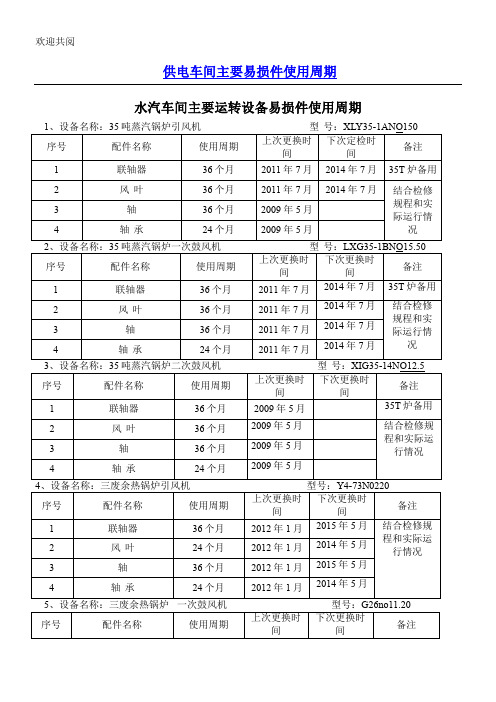
供电车间主要易损件使用周期
水汽车间主要运转设备易损件使用周期
设备名称:7 #压缩机型号:4M8 设备名称:8 #压缩机型号:4M8
运转设备易损件台帐设备名称:2#循环机型号:1.9
设备名称:3#循环机型号:1.9
运转设备易损件台帐设备名称:5#循环机型号:1.8
设备名称:6#循环机型号:1.8
运转设备易损件台帐
运转设备易损件台帐设备名称:9#循环机型号:1.8
设备名称:3#冷排循环水泵型号:
设备名称:3#盐水泵型号:
转设备易损件台帐
运转设备易损件台帐设备名称:1#屏蔽泵型号:
设备名称:2#屏蔽泵型号:
#
硝盐车间易损备件更换周期
硝盐车间易损备件更换周期。
一周计划工作表格模板word打印版(5种经典款)

备 注
星期一
2020-3-9
1
2
3
4
星期二
2020-3-10
1
2
3
4
星期三
2020-3-11
1
2
3
4
星期四
2020-3-12
1
2
3
4
星期五
2020-3-13
1
2
3
4
周工作总结
一周工作计划表
周期: 月日-月日计划人:
本周主要
任务目标
注意:一周工作计划表均采用word制作,下周后可以任意修改。
日期
主要工作安排
完成情况
备注
星期一
月日
星期二
月日
星期三
月日
星期四
月日
星期五
月日
周 末
月日
一周工作Байду номын сангаас划表
部门名称:
填报人:
日期:
本周主要
任务目标
任务分解(每日工作安排明细)
日期/星期
主要工作安排
工作完成标准
备注
月日
星期一
月日
星期二
月日
星期三
月日
星期四
月日
星期五
月日
周末
一周工作计划表
部门:计划人:
周工作目标
周工作内容
( 年 月 日~ 年 月 日 )
时间
工作内容
完成进度
周一
周二
周三
周四
周五
周六
周日
维度
时间
重要紧急
重要不紧急
紧急不重要
不重要不紧急
周一
元素周期表探秘PPT模板
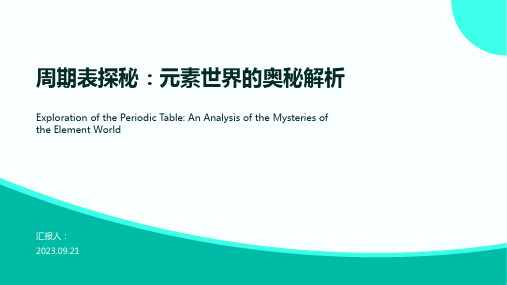
元素周期表的起源
1. 元素周期表的起源可以追溯到19世纪初,当时科学家们开始尝试将已知的 元素按照某种规律进行排列。这一过程经历了多次尝试和改进,最终在1869 年由俄罗斯化学家门捷列夫提出了现代元素周期表的基本框架。 2. 门捷列夫的元素周期表采用了类似于音乐的音阶结构,将已知的元素按照 原子质量从小到大排列,并将具有相似化学性质的元素放在同一列。这种排 列方式使得元素的性质和周期性规律变得更加清晰可见。 3. 随着科学技术的发展,元素周期表不断得到完善和扩展。例如,后来发现 了更多的元素,如镧系元素和锕系元素;同时,科学家们还发现了许多元素 的同位素,这些同位素的存在使得元素周期表更加丰富多样。 4. 如今,元素周期表已经成为了化学领域的基础工具,广泛应用于药物研发、 材料科学、能源开发等多个领域。通过对元素周期表的研究,科学家们可以 更好地理解元素的结构和性质,从而推动科学技术的进步。
01
元素周期表的发展历程
The Development History of the Periodic Table of Elements
元素周期表的起源
The Origin of the Periodic Table of Elements
1. 元素周期表起源于19世纪初,当时科学家们对元素的分类和性质产生了 浓厚的兴趣。通过对已知元素的观察和实验,科学家们发现这些元素具有周 期性的性质,如原子半径、电离能等。因此,他们将这些元素按照一定的规 律排列起来,形成了元素周期表的基本框架。
2. 元素周期表的诞生为化学领域带来了革命性的变化。在此之前,人们对 元素的了解仅限于它们的名称和简单的性质描述。而元素周期表的出现使得 科学家们能够更系统地研究元素之间的关系,从而推动了化学理论的发展和 完善。
计划时间节点表模板

计划时间节点表模板全文共四篇示例,供读者参考第一篇示例:计划时间节点表,是项目管理中非常重要的一项工具。
通过制定和遵循时间节点表,能够帮助项目团队合理安排项目进度,提高工作效率,避免延误和项目风险。
在制定时间节点表时,需要考虑项目的整体目标和时间限制,合理分配各项任务和阶段的时间,以确保项目能够按时完成。
时间节点表通常包括项目的开始日期、结束日期、里程碑事件、任务列表、负责人以及实际完成日期等内容。
以下是一个简单的计划时间节点表模板,供大家参考。
| 时间节点| 任务内容| 负责人| 完成日期|| --------| --------| -----| --------|| 1 | 确定项目范围和目标| 项目经理| 2022年1月1日|| 2 | 制定项目计划和时间表| 项目经理| 2022年1月5日|| 3 | 确定项目预算和资源| 项目经理| 2022年1月10日|| 4 | 召集项目团队会议| 项目经理| 2022年1月15日|| 5 | 确定项目分工和责任| 项目经理| 2022年1月20日|| 6 | 进行项目实施和监控| 项目团队| 持续进行|| 7 | 完成项目验收和交付| 项目经理| 2022年2月28日|| 8 | 撰写项目总结报告| 项目经理| 2022年3月5日|在实际制定时间节点表时,还需要根据项目的具体情况做进一步的调整和补充。
在任务内容中可以进一步拆分出具体的工作内容和工作量,以便更好地分配资源和监控进度。
在负责人一栏中可以列出每个任务的具体执行人员,以确保每个任务都有明确的执行责任和方向。
在完成日期一栏中可以跟踪记录实际完成时间,及时发现并解决延误问题。
在制定时间节点表的过程中,需要主要考虑以下几个方面:1. 合理规划时间:根据项目的具体要求和时间限制,制定合理的时间节点表。
避免时间节点过于紧张或过于宽松,应该根据实际情况进行适当的调整。
2. 确保任务清晰:每个时间节点表中的任务内容应该清晰明了,避免模糊和不清晰的任务描述,以免影响项目的进展和效率。
产品开发节点计划表 模板
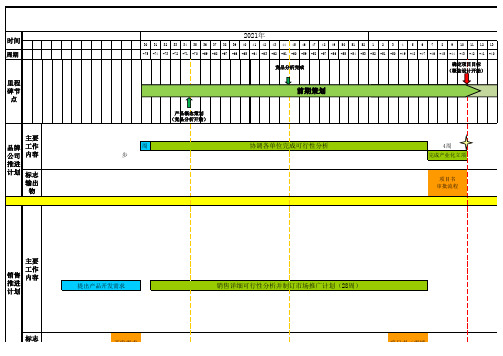
11 12 13 14 15 16 17 18 19 20 21 22 23 24 25 26 27 28 29 30 31 32 33 34 35 36 37 38 39 40 41 42 43 44 45 46 47 48 49 50 51 52 53 54 55 56 57 58 59
零部件数据冻结
物
项目书(需制造 完成部分)
10周 参与项目预算编制并进行投资收益分析
项目书(需财务 完成部分)
2022年
14 15 16 17 18 19 20 21 22 23 24 25 26 27 28 29 30 31 32 33 34 35 36 37 38 39 40 41 42 43 44 45 46 47 48 49 50 51 52 1 2 3 4 5 6 7 8 9 10
冻结版零部件3D 数据
零部件开模指令
工程设计冻 结评审报告
焊装夹具验收报 告
检验规格
样件检验报告 软模件验收报告
3D数
工程样车40台(13周) 基本性能及可靠性试验I(
第
转向系统匹配 性
能
开
发
、
试
验
悬置匹配
验 证
进排气系统匹配
基础标定(12周)
第一轮车身结构验证 6周 EMC摸底
工程样车
质量培育,并确保供应商提交合格工装样件
109 110 111 112 113 114 115 116 117 118 119 120 121 122 123 124 125 126 127 128 129 130 131 132 133 134 135 136 137 138 139 140 141 142 143 144 145 146 147 148 149 150 151 152 153 154 155 156 157
最新元素周期表(新)
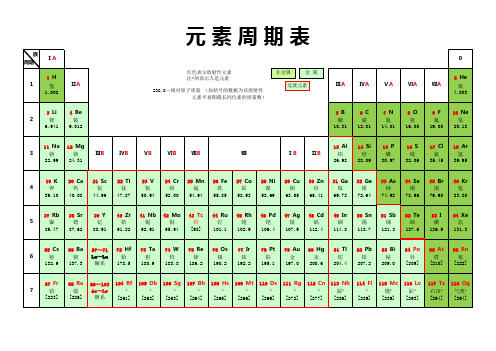
40 Zr 锆 91.22
41 Nb 铌 92.91 Nhomakorabea42 Mo 钼 95.94
43 Tc 锝 [98]
44 Ru 钌 101.1
45 Rh 铑 102.9
46 Pd 钯 106.4
47 Ag 银 107.9
48 Cd 镉 112.4
49 In 铟 114.8
50 Sn 锡 118.7
51 Sb 锑 121.8
52 Te 碲 127.6
53 I 碘 126.9
54 Xe 氙 131.3
6
55 Cs 铯 132.9
56 Ba 钡 137.3
57~71 La~Lu 镧系
72 Hf 铪 178.5 104 Rf ������ [261]
*
73 Ta 钽 180.9 105 Db ������ [262]
*
74 W 钨 183.8 106 Sg ������ [263]
*
85 At 砹 [210] 117 Ts 石田 [294]
*
86 Rn 氡 [222] 118 Og 气奥* [294]
7
87 Fr 钫 [223]
88 Ra 镭 [226]
89~103 Ac~Lr 锕系
16 S 硫 32.06
17 Cl 氯 35.45
18 Ar 氩 39.95
4
19 K 钾 39.10
20 Ca 钙 40.08
21 Sc 钪 44.96
22 Ti 钛 47.87
23 V 钒 50.94
24 Cr 铬 52.00
25 Mn 锰 54.94
26 Fe 铁 55.85
27 Co 钴 58.93
元素周期表结构课堂教学设计
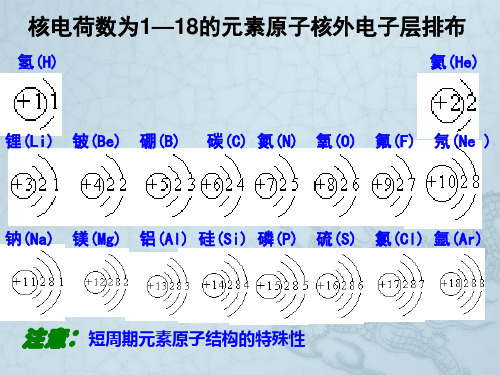
引力 力
(电子层数的影响大于核电荷数的影响)
碱金属元素原子的还原性、金属性、失电子能力强 弱顺序为: Cs>Rb> K> Na>Li
碱金属元素离子的氧化性、得电子能力强弱顺序为:
Cs+<Rb+< K+< Na+<Li+
3、碱金属单质的主要物理性质
Li保存在石蜡中,K,Na保存在石蜡或煤油中
碱金属的物理性质的比较
Li Na K Rb Cs
相
颜色
均为银白色(Cs略带金色)
硬度 似
柔软
密度
较小
点 熔沸点
较低
导电导热性
递 变
密度变化
性 熔沸点变化
强 逐渐增大(K特殊) 单质的熔沸点逐渐降低
(2)碱金属元素原子的电子层数递增, 原子半径递增,它们的化学性质差异性
碱金属与氧气反应比较
单质 Li Na K Rb Cs
2.递变性: 核电 荷数
电子 层数
原子 半径
核对 得 最外 电 层电 子
氧 化 性
非 金 属
子的 能
性
引力 力
(电子层数的影响大于核电荷数的影响)
卤素元素原子的氧化性、非金属性、得电子能力强
弱顺序为: F>Cl> Br> I
卤素元素离子的还原性、失电子能力强弱顺序为:
F-<Cl - <Br -< I-
已知元素在周期表中的 位置推断原子结构和元素性质
根据元素的原子结构或性质 推测它在周期表中的位置
碱金属元素单质 Rb
1、碱金属元素的原子结构
思考与交流 碱金属的原子结构示意图
模具制作周期表
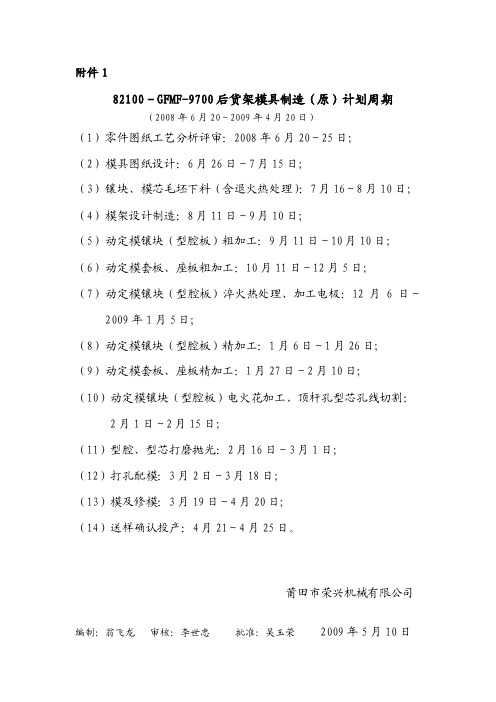
附件182100-GFMF-9700后货架模具制造(原)计划周期(2008年6月20~2009年4月20日)(1)零件图纸工艺分析评审:2008年6月20~25日;(2)模具图纸设计:6月26日~7月15日;(3)镶块、模芯毛坯下料(含退火热处理):7月16~8月10日;(4)模架设计制造:8月11日~9月10日;(5)动定模镶块(型腔板)粗加工:9月11日~10月10日;(6)动定模套板、座板粗加工:10月11日~12月5日;(7)动定模镶块(型腔板)淬火热处理、加工电极:12月6日~2009年1月5日;(8)动定模镶块(型腔板)精加工:1月6日~1月26日;(9)动定模套板、座板精加工:1月27日~2月10日;(10)动定模镶块(型腔板)电火花加工、顶杆孔型芯孔线切割:2月1日~2月15日;(11)型腔、型芯打磨抛光:2月16日~3月1日;(12)打孔配模:3月2日~3月18日;(13)模及修模:3月19日~4月20日;(14)送样确认投产:4月21~4月25日。
莆田市荣兴机械有限公司编制:翁飞龙审核:李世忠批准:吴玉荣2009年5月10日82100-GFMF-9700后货架压铸模具制造计划缩短周期说明82100-GFMF-9700后货架压铸模具按传统的制造计划,从产品压铸毛坯图、压铸模具图纸设计审核、模具模板、型腔板毛坯下料,退火热处理、粗加工、淬火热处理、电火花加工、线切割、精加工、抛光、装配、试模及修模至送样确认,整个制造周期约需要10个月以上。
主要原因一:其中部分模具加工设备非数控设备;原因二:模具设计未采用CAE模拟仿真技术,需要通过经验法和试误法来设计浇道及求得较适当的工艺参数,这些方法需要反复的试验,要花费大量的时间。
而本项目“GFMG后货架压铸模具的研发”在完成前期工作(包括搜索技术资料、信息、项目可行性分析,确定开发项目)后,购置了大型数控设备,确立了研究开发方案,即应用CAD/CAM/CAE 软件技术设计制造压铸模具,大大优化了模具设计(包括浇注系统、冷却系统、排气系统),优化了模具制造和压铸成形工艺,提高了模具零件加工速度和精度,最主要是减少了模具反复试模和修模次数,从而使模具制造周期从10个月缩短至4个月。
